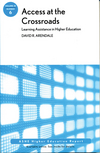 With this blog posting, I pick back up on my series of samples from my book, Assistance at the Crossroads described in the left-hand column of this website. There are many ways that academic help can be provided for college students who are struggling in some of their classes.
With this blog posting, I pick back up on my series of samples from my book, Assistance at the Crossroads described in the left-hand column of this website. There are many ways that academic help can be provided for college students who are struggling in some of their classes.
This learning assistance approach operates through concurrent learning experiences. Students simultaneously enroll in a college-level class, whether or not they have been identified as academically underprepared, and use learning assistance services to support their learning in that class. A common characteristic of such a class is academic rigor exceeding the average of other college-level classes. These courses are challenging for many students, and the classes have high withdrawal and failure rates. Sometimes they are called “gatekeeper” classes (Jenkins, Jaggars, and Roksa, 2009).
For purposes of this discussion, this historically difficult class is called a “target class,” as learning assistance services are customized and “targeted” for serving students enrolled in that specific course. Other students in the same class that have not been identified as academically underprepared for content material in that particular class are welcome to use the learning assistance activities as supplemental or enrichment experiences to deepen mastery of course content. This concurrent acquisition approach is divided into three smaller groups of activities: those offered as supplemental learning experiences through the student’s voluntary participation; those offered as a coordinated program that requires moderate involvement by the target course instructor; and those embedded, infused, or mainstreamed in the course targeted for academic support that thereby serve all students enrolled in the class, regardless of their academic preparation.
One of the activities described in the previous section on prerequisite acquisition approaches could also have appeared in this section. Because most students enroll in only a single developmental course, the rest of their courses are at the college level. These students concurrently develop competency through the developmental course while they advance their knowledge and skills through the college-level courses. The key issue that places developmental courses in the previous section is that students are not ready to enroll in the college-level course for which they are underprepared. They are, however, ready for enrollment in other college-level courses. (To be continued.....)
